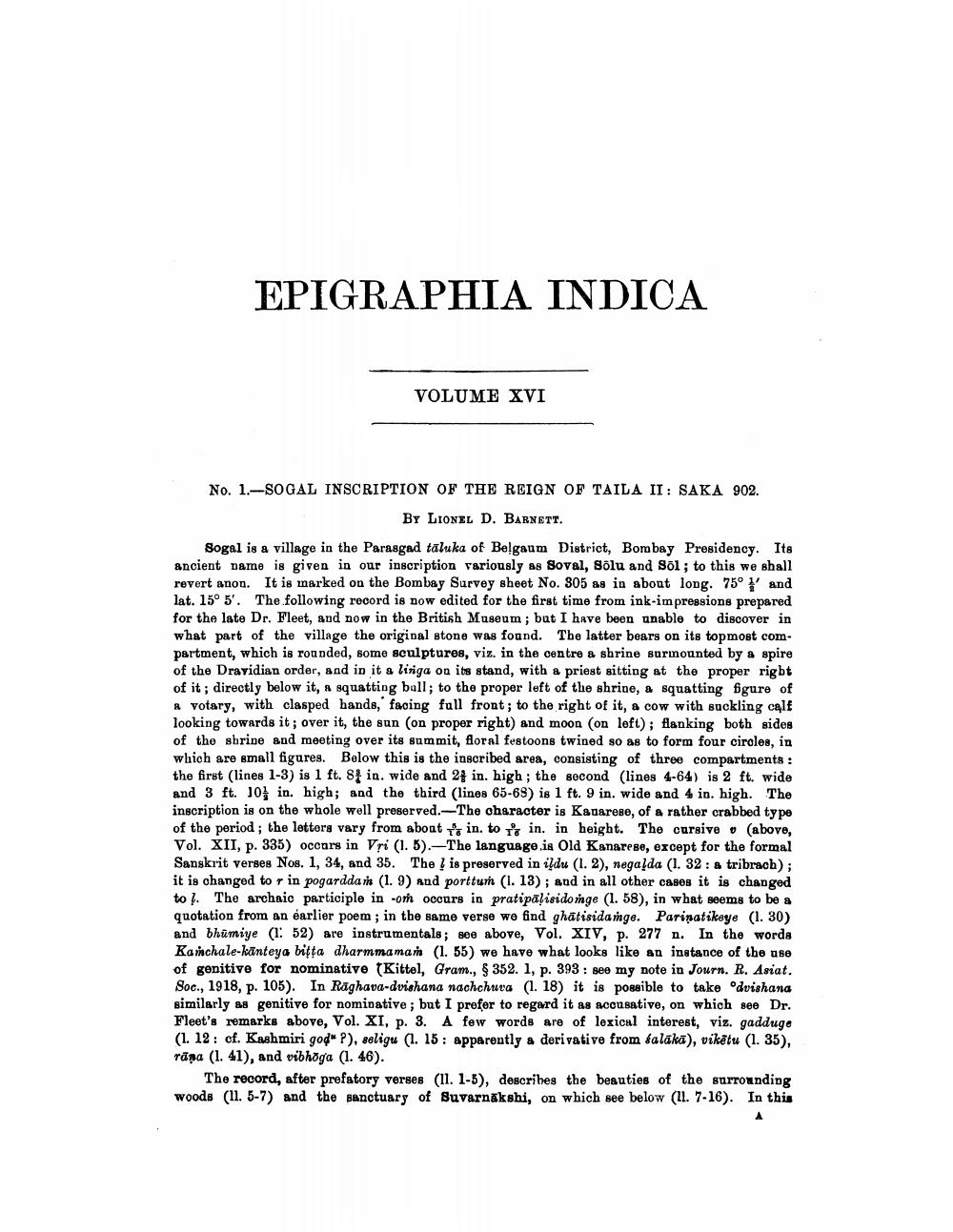________________
EPIGRAPHIA INDICA
VOLUME XVI
No. 1.-SOGAL INSCRIPTION OF THE REIGN OF TAILA II: SAKA 902.
BY LIONEL D. BARNETT.
Sogal is a village in the Parasgad taluka of Belgaum District, Bombay Presidency. Its ancient name is given in our inscription variously as Soval, Sōlu and Sol; to this we shall revert anon. It is marked on the Bombay Survey sheet No. 305 as in about long. 75° and lat. 15° 5'. The following record is now edited for the first time from ink-impressions prepared for the late Dr. Fleet, and now in the British Museum; but I have been unable to discover in what part of the village the original stone was found. The latter bears on its topmost compartment, which is rounded, some sculptures, viz. in the centre a shrine surmounted by a spire of the Dravidian order, and in it a linga on its stand, with a priest sitting at the proper right of it; directly below it, a squatting ball; to the proper left of the shrine, a squatting figure of a votary, with clasped hands, facing full front; to the right of it, a cow with suckling calf looking towards it; over it, the sun (on proper right) and moon (on left); flanking both sides of the shrine and meeting over its summit, floral festoons twined so as to form four circles, in which are small figures. Below this is the inscribed area, consisting of three compartments: the first (lines 1-3) is 1 ft. 8 in. wide and 2 in. high; the second (lines 4-64) is 2 ft. wide and 3 ft. 10 in. high; and the third (lines 65-68) is 1 ft. 9 in. wide and 4 in. high. The inscription is on the whole well preserved.-The character is Kanarese, of a rather crabbed type of the period; the letters vary from about in. to in. in height. The cursive (above, Vol. XII, p. 335) occurs in Vri (1. 5). The language.is Old Kanarese, except for the formal Sanskrit verses Nos. 1, 34, and 35. The is preserved in ildu (1. 2), negalda (1. 32: a tribrach); it is changed to r in pogarddam (1. 9) and porttum (1. 13); and in all other cases it is changed to. The archaic participle in -om occurs in pratipalisidonge (1. 58), in what seems to be a quotation from an earlier poem; in the same verse we find ghatisidamge. Parinatikeye (1.30) and bhumiye (1 52) are instrumentals; see above, Vol. XIV, p. 277 n. In the words Kamchale-kanteya biṭṭa dharmmamam (1. 55) we have what looks like an instance of the use of genitive for nominative (Kittel, Gram., § 352. 1, p. 393: see my note in Journ. R. Asiat. Soc., 1918, p. 105). In Raghava-dvishana nachchuva (1. 18) it is possible to take "dvishana similarly as genitive for nominative; but I prefer to regard it as accusative, on which see Dr. Fleet's remarks above, Vol. XI, p. 3. A few words are of lexical interest, viz. gadduge (1. 12: of. Kashmiri god" ?), seligu (1. 15: apparently a derivative from salākā), vikētu (1. 35), rāna (1. 41), and vibhoga (1. 46).
The record, after prefatory verses (11. 1-5), describes the beauties of the surrounding woods (11.5-7) and the sanctuary of Suvarnakshi, on which see below (l1. 7-16). In this




